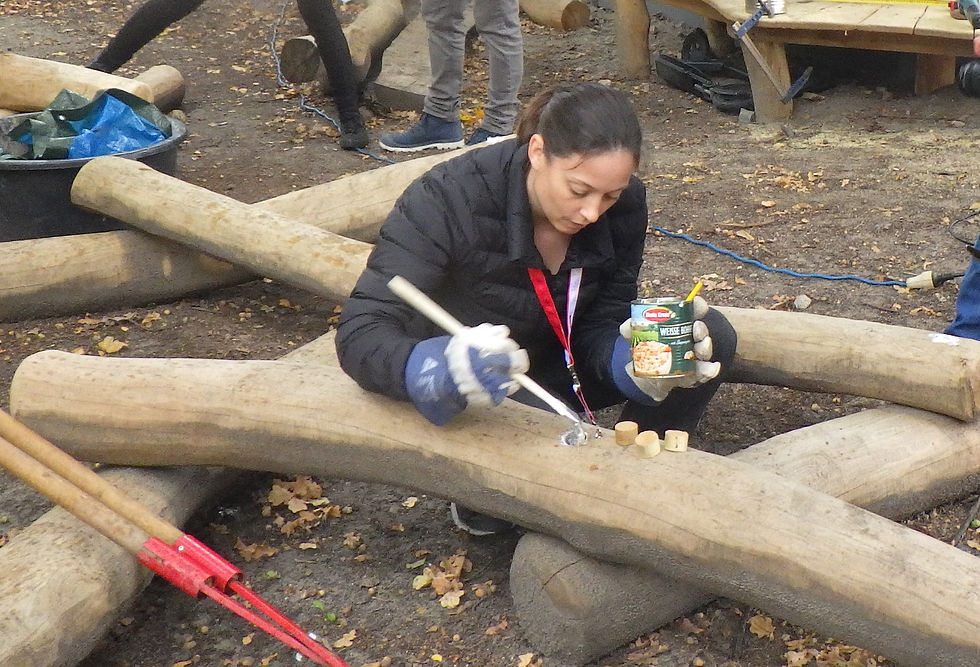2017 ISGA Conference A Success!
- Julie Mountain
- Mar 28, 2018
- 2 min read
Updated: Mar 3, 2024
On September 4-6, 2017, 130 landscape architects, designers, educators, school principals, local representatives, and scientists from around the world gathered in Berlin. Representing 21 countries from around the world and numerous educational systems, all were united by one goal: transforming standard schoolyards into a diverse array of landscapes for playing, moving and learning!
Conference participants were immersed in a wide variety of learning experiences. On Day One, lectures provided international perspectives on the importance of well-designed open spaces in educational institutions. Specific topics included schoolyard plans created by undergraduate students in Denver, USA and Japan; the very first attempts of designing outdoor playgrounds in China; alternative educational concepts of natural and environmental schools in Sweden; and innovative educational concepts in Germany. Presenters discussed the need to rethink and design learning spaces in a completely different way, not only indoors but especially outside.




















Excursions across Berlin gave the participants first‐hand experience in Berlin’s innovative schoolyards. They were able to witness directly and concretely how only outdoor areas are capable of providing children and youth with direct contact to the natural environment. Natural phenomena, weather and climate, animals and plants, and natural elements such as water, earth, and air were experienced together with the children, and understood as part of an "Education for Sustainable Development".
On the last day of the conference, participants joined together with pupils of the Otto-Wels Primary School to transform the schoolyard with 12 artistic workshops, including creating mosaics, wicker igloos, stone and tree carvings, painting, and building balancing structures. These crafts brought to life a design developed with intensive participation of the school community and and provided a wonderful sense of achievement, and connection on which to end the conference. It made evident how creativity, teamwork, pleasure, fun and mutual support enabled people of different cultures to reach a common goal that everyone could be proud of: changing together the "Schoolyard Living Space" positively, child-‐friendly, ecological and sustainable.
Overall the conference was a great success. The new ideas and connections made through the lectures, workshops, excursions, and other events provided an impetus for further learning and action to all participants and their home institutions and organizations. We hope that the excitement it generated will encourage imitation across Berlin, Germany, and around the world!
“It is urgent to implement the planning and design of open spaces for children, whether in schools, kindergartens, living areas in cities and countryside. This must be done according to child‐appropriate design criteria and with a serious participation of the users, or by schoolyard designers who are specialized in user-oriented open space design. In-depth teaching, research, practice-oriented study projects, in-service training and, of course, continuous interdisciplinary exchange are urgently needed on this topic.”
— Manfred Dietzen, conference leader

Sebagai situs terkemuka di tahun 2025, platform ARIZONA88 menyediakan pengalaman bermain Toto Slot Gacor yang tak tertandingi dengan berbagai pilihan toto togel 4D dan slot jackpot menggiurkan. Para pemain dapat menikmati keseruan dan peluang kemenangan besar dalam setiap taruhan.
Arizona88 menjadi pilihan utama bagi penggemar judi daring yang mencari link Toto Togel 4D terpercaya dengan koleksi slot gacor terupdate dan pasaran toto 4D yang fair dan aman, menjamin keamanan serta kenyamanan pemain.
Situs Toto Terbaik hadir sebagai wadah bagi pecinta Togel Online yang mendambakan kemenangan harian melalui berbagai permainan toto 4D dan slot dengan jaminan pembayaran jackpot yang konsisten.
Link Toto Slot menyediakan akses mudah ke berbagai permainan Toto Togel 4D resmi dan terpercaya, serta menawarkan pilihan toto slot menarik…
Sebagai pilihan utama, ARIZONA88 menawarkan pengalaman bermain Arizona88 toto slot terbaik dan togel online paling gacor, menjanjikan keseruan serta potensi kemenangan tinggi bagi para pemain. Dikenal sebagai ARIZONA88 Toto Togel 4D dan togel online yang mudah menang tiap hari, platform ini menyediakan beragam permainan menarik dengan peluang keuntungan konsisten.
Menghadirkan kombinasi menarik antara Togel Online dan Slot88 gacor, situs toto ini memberikan variasi permainan seru dengan potensi menang menguntungkan bagi para pemain. ARIZONA88 juga viral dengan Toto Togel 4D online berhadiah rekor di tahun 2025, serta pilihan toto slot yang inovatif dan menghibur.
Sebagai situs Toto Togel Resmi 4D, Arizona88 menjamin pembayaran cepat dan juga menawarkan berbagai slot gacor dengan potensi maxwin yang menggiurkan bagi para pemain. Platform ini memberikan…
Informasi lengkap mengenai Pengeluaran Macau 4D dapat ditemukan di situs ini, menyajikan update terkini tentang Toto Macau Pools dan Data Macau secara akurat. Para pemain togel Macau dapat memanfaatkan keluaran Macau hari ini dan result togel Macau untuk menganalisis tren dan meningkatkan strategi bermain mereka.
Bagi penggemar Toto Togel HK, situs ini menyediakan prediksi keluaran togel HK hari ini serta informasi mengenai bandar togel Hongkong terpercaya. Dengan data yang komprehensif, para pemain dapat merencanakan taruhan mereka dengan lebih baik dan menemukan platform bermain yang aman dan terjamin.
Arizona88 hadir sebagai situs terpercaya untuk para penggemar Slot Online dan Toto Togel 4D, menyediakan kemudahan login dan berbagai pilihan permainan yang menarik. Platform ini menawarkan pengalaman bermain yang aman dan nyaman bagi…
link link link link link link link link link link link link link link link link link link link link link link link link link link link link link link link link link link link link link link link link link link link link link link link link link link link link link link link link link link link link link link link link link link link link link link link link link link link link link link link link link link link link link link link link link link link link link link link link link link link link
Looking for the ultimate trendsetter? The Jacket 8 Ball is here to take your style up a notch. Leather Moto ensures premium quality with a touch of vintage charm. Whether you're a fashion lover or a collector, this piece belongs in your closet. Stay ahead of the trends with a jacket that speaks confidence. Don’t wait—get yours now!